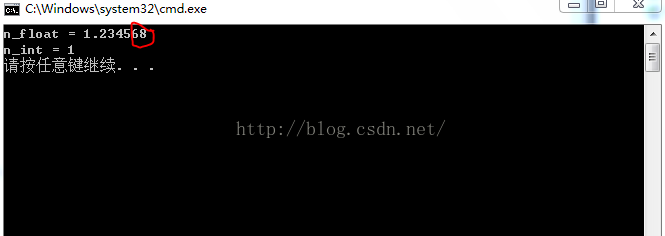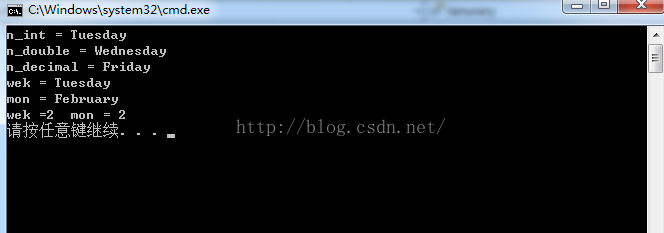
C#の型変換には、前回の記事で紹介した暗黙的な型変換の他に、宣言が必要な型変換-----明示的な型変換があります
「明示的な型変換」とも呼ばれます。強制型変換 では、変換時に変換型を明示的に指定する必要があります。たとえば、long 型を int 型に変換する場合、この変換は精度を失う変換であるため、システムは暗黙的な変換を自動的に実行しません。したがって、強制変換する必要があります:
long l = 6000;
int i = (int)l; //需要用在 ()里面声明转换类型表示タイプの変換は、次のような 2 つのタイプには当てはまりません:
int i = 6000;
string i = (string)i; //这里会报错したがって、表示タイプの変換には特定のルールがあります:
表示数値変換。
表示列挙変換; int i = 6000;
long l = (long)i; //等价于 long l = i;表示値変換。これは、値の型間の変換を指します。値の型には次の規則があります:
sbyte から byte、ushort、uint、ulong、char 型
ushort から sbyte、byte、short、char 型へ;
int から sbyte、byte、short、ushort、uint、ulong、char 型へ。
uintからsbyte、byte、short、ushort、int、char型へ;
longからsbyte、byte、short、ushort、int、uint、ulong、char型へ
ulongからsbyte、byte、short、ushort、int、uint、long、char 型へ
char から sbyte、byte、short 型へ
float から sbyte、byte、short、ushort、int、uint へ、long、ulong、char、10 進数型
double から sbyte、byte、short、ushort、int、uint、long、ulong、float、char、10 進数型へ
10 進数から sbyte、byte 、short、ushort、int、uint、long、ulong、Float、char、double 型;
ここまで書いたら、高精度から低精度への変換です。または丸め変換の例を書いてみましょう:
using System;
using System.Collections.Generic;
using System.Linq;
using System.Text;
namespace Test
{
class Program
{
static void Main(string[] args)
{
double n_double = 1.73456789;
float n_float = (float)n_double; //显示转换 float的有效为只有8位(.也是一位)所以从第9位四舍五入
int n_int = (int)n_double; //只保留整数
Console.WriteLine("n_float = {0}\nn_int = {1}",n_float,n_int);
}
}
}比較すると、double データ範囲が float の有効な値の範囲を超える場合、表示変換中に 9 桁目が丸められることがわかりました。 int型に変換すると整数部分のみが残ります。
 表示列挙型変換には次の内容が含まれます:
表示列挙型変換には次の内容が含まれます:
sbyte、byte、short、ushort、int、uint、long、ulong、float、char、double、10 進数型から任意の列挙型へ型;
任意の列挙型から sbyte、byte、short、ushort、int、uint、long、ulong、float、char、double、10 進数型へ。
例を書きます:
using System;
using System.Collections.Generic;
using System.Linq;
using System.Text;
namespace Test
{
class Program
{
enum weekday //定义2个枚举
{Sunday,Monday,Tuesday,Wednesday,Thursday,Friday,Saturday }
enum Month
{Janurary=1,February,March,April,May,Jun,July }
static void Main(string[] args)
{
int n_int = 2;
double n_double = 3.0;
decimal n_decimal = 5m; //声明decimal 类型要加m
weekday weki = (weekday)n_int; //从int、double、decimal到枚举转换
weekday wekd = (weekday)n_double;
weekday wekde = (weekday)n_decimal;
weekday wek = weekday.Tuesday; //枚举类型之间的转换
Month mon = (Month)wek;
int i = (int)wek; //从枚举类型到int的转换
int t = (int)mon;
Console.WriteLine("n_int = {0}\nn_double = {1}\nn_decimal = {2}",weki,wekd,wekde);
Console.WriteLine("wek = {0}\nmon = {1}\nwek ={2}\tmon = {3}",wek,mon,i,t);
}
}
}using System;
using System.Collections.Generic;
using System.Linq;
using System.Text;
namespace Test
{
class Program
{
//定义2个类 teacher与man
class teacher
{ }
class man
{ }
static void Main(string[] args)
{
man per = new man(); //将man实例化一个对象per
object o = per; //装箱
teacher p = (teacher)o; // 将o显示转换为teacher类
}
}
}using System;
using System.Collections.Generic;
using System.Linq;
using System.Text;
namespace Test
{
class Program
{
class man //定义一个基类
{ }
class student:man //student继承man
{ }
static void Main(string[] args)
{
man per = new man(); //man实例化一个对象per
student stu = (student)per; //将父类转换为子类
}
}
}System.Collections.Generic を使用; System.Linq を使用;
System.Linq を使用;
namespace Test
{
class Program
{
public interface teacher //定义一个接口
{ }
class student //定义一个类
{ }
static void Main(string[] args)
{
student stu = new student(); //实例化一个对象
teacher tea = (teacher)stu; // 显示转换
}
}
}using System;
using System.Collections.Generic;
using System.Linq;
using System.Text;
namespace Test
{
class Program
{
public interface man //定义一个接口
{ }
class teacher:man //定义一个继承于man的类man
{ }
class student //定义一个新类
{ }
static void Main(string[] args)
{
man teac=new teacher(); //间接实例化一个接口
student stu = (student)teac; // 显示转换
}
}
}using System;
using System.Collections.Generic;
using System.Linq;
using System.Text;
namespace Test
{
class Program
{
public interface man //定义一个接口
{ }
class teacher : man //由接口派生一个类
{ }
public interface person //定义一个接口
{ }
class student:person //由接口派生一个类
{ }
static void Main(string[] args)
{
man teac=new teacher(); //间接实例化一个接口
person stu = (person)teac; // 显示转换
}
}
}using System;
using System.Collections.Generic;
using System.Linq;
using System.Text;
namespace Test
{
class Program
{
class teacher
{ }
class student:teacher //studnet继承teacher
{ }
static void Main(string[] args)
{
teacher[] teac = new teacher[5];
student[] stu = new student[5];
stu = (student[])teac; //显示转换
}
}
}using System;
using System.Collections.Generic;
using System.Linq;
using System.Text;
namespace Test
{
class Program
{
static void Main(string[] args)
{
double[] n_double = new double[5];
float[] n_float = new float[5];
n_float = (float[])n_double; //这里出错啦
}
}
}using System;
using System.Collections.Generic;
using System.Linq;
using System.Text;
namespace Test
{
class Program
{
static void Main(string[] args)
{
Array arr = new Array[5]; //定义一个Array类型的数组并初始化
double[] d = new double[5];
d = (double[])arr; //显示转换
}
}
}using System;
using System.Collections.Generic;
using System.Linq;
using System.Text;
namespace Test
{
class Program
{
public static delegate int mydele(); //声明一个委托
class DE : Delegate //定义一个继承于Delegate 的类DE
{ }
static void Main(string[] args)
{
Delegate MY =new DE(); // 将Delegate 抽象类间接实例化
mydele my = (mydele)MY; //显示转换
}
}
}以上は C# 学習日記 17 の内容です ---型変換の具体的な使用例については、PHP 中国語 Web サイトをご覧ください。 (www.php.cn)!